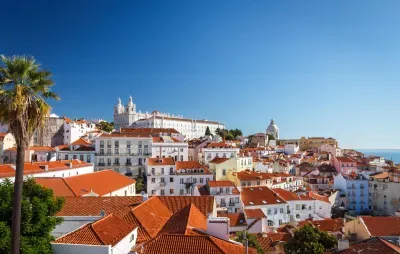
Queluz National Palace 
Ambassedors' Hall - Queluz Palace José Manuel All rights reserved
The clock tower / Pousada D. Maria José Manuel All rights reservedThe Palace at Queluz was built in the latter half of the 18th century from a design by two of the periods most esteemed architects; Frenchman Jean-Baptiste Robillon and the Portuguese Mateus Vicente de Oliveira. Together they created this "Portuguese Versailles" in the Rococo style as a manor house for King Pedro II.
During the reign of Maria I (1777-99) Queluz becamethe official residence of the Royal family. Unfortunately for Maria I she is largely remembered for her bouts of mania followed by slumps into prolonged depressions.
The main façade of the palace is relatively unprepossessing by the standards of the time. However, any sense of modesty is abandoned on the interior. It is little surprise that the throne room is the most lavish; this hall is a celebration of opulence with enormous chandeliers and gold gilt laden walls and ceilings.The Hall of the Ambassadors is only slightly less luxuriant, and no less grand. The chequered black and white marble floor resembles a giant chess board, there are enormous ornate mirrors on the wall and at the end of the room are the thrones where the royals would hold court of visiting dignitaries. On the ceiling is a large fresco of the royal family attending a concert.
The formal gardens are very extensive with paths laid out in geometric patterns between hedges cut into an array of designs. There are classically themed fountains and statues along with the elaborate "Lion's Staircase" (Escadaria dos Leoes). A little of the formality is relieved by the great old magnolia trees and the orchards of orange trees.
Perhaps the most unique feature at Queluz is the azulejo-lined canal. Enclosed between restraining walls a local stream was diverted and controlled by a makeshift dam which allowed an impromptu river to be created whenever the royal family wanted to go boating.
The palace kitchens have now become a restaurant called Cozinha Velha - meaning the old kitchen. This is worth a visit just to get a glimpse into the working of a palace kitchen. There are huge old cooking utensils, a fireplace big enough to live in and a vaulted stone ceiling. Apparently the desserts here are made to ancient secret recipes.
Over the years the pink palace at Queluz has had many roles. At one point in the early 19th century it was the site of the royal zoo with exotic animals such as lions and wolves kept here. These days it is open to the public, however it is still a National Palace and has seen many heads of state and dignitaries stay and dine here throughout the years.
The Royal Guard building across the courtyard now serves as a pousada.
Address
Largo Palácio de QueluzQueluzLisbon2745-191Phone
+351 21 434 3860Link
http://www.parquesdesintra.pt/en/parks-and-monuments/national-palace-and-gardens-of-queluz/Attraction type

Lisbon travel guide »
Lisbon is one of the most immediately likeable capitals in Europe. Located on the westernmost front of Continental Europe, its mosaic of terracotta roofed buildings cling both majestically and humbly to its seven hills. The Tejo River sweeps past the many character-rich districts which border it, carrying boats big and small and is straddled by two impressive bridges. Some ultra modern…